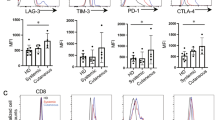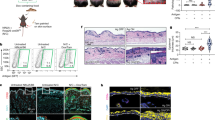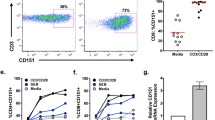Abstract
In early stages of cutaneous T cell lymphoma (Sézary syndrome) both CD4+CD7− and CD4+CD7+ T cells clonally expand whereas in late stages of the disease CD7− cells are predominant in number, giving rise to the question whether CD7− T cells have a survival advantage in the skin. Galectin-1, a cell-bound lectin, was recently reported to trigger apoptosis in activated CD7+ T cells. Here, we demonstrate that in contrast to activated CD7+ T cells, quiescent and activated CD69+ CD7− T cells from healthy donors and from Sézary patients are resistant to galectin-1-mediated cell death. CD7− T cells are apoptosis-resistant even during coculture with IFN-γ-stimulated endothelial cells that constitutively express galectin-1 in high amounts. These data imply that resistance of CD7− T cells to galectin-1-induced apoptosis may contribute to the accumulation of CD7− Sézary T cells during progression of the disease.
This is a preview of subscription content, access via your institution
Access options
Subscribe to this journal
Receive 12 print issues and online access
$259.00 per year
only $21.58 per issue
Buy this article
- Purchase on Springer Link
- Instant access to full article PDF
Prices may be subject to local taxes which are calculated during checkout

Similar content being viewed by others
References
Willemze R, Sterry W, Berti E, Cerroni L, Chimenti S, Diaz-Pérez JL, Geerts ML, Goos M, Knobler R, Ralfkiaer E, Santucci M, Smith N, Wechsler J, van Vloten WA, Meijer CJ . EORTC classification for primary cutaneous lymphoma: a proposal from the cutaneous study group of the European organisation for research and treatment of cancer Blood 1997 90: 354–371
Diamandidou E, Cohen PR, Kurzrock R . Mycosis fungoides and Sezary syndrome Blood 1996 88: 2385–2409
Reinhold U, Abken H . CD4+CD7− T cells: a separate subpopulation of memory T cells? J Clin Immunol 1997 17: 265–271
Bogen SA, Pelley D, Charif M, McCusher M, Koh H, Foss F, Garifallou M, Arkin C, Zucker-Franklin D . Immunophenotypic identification of Sezary cells in peripheral blood Am J Clin Pathol 1996 106: 739–748
Harmon CB, Witzig TE, Katzmann JA, Pittelkow MR . Detection of circulating T cells with CD4+CD7− immunophenotype in patients with benign and malignant lymphoproliferative dermatoses J Am Acad Dermatol 1996 35: 404–410
Rappl G, Muche JM, Abken H, Sterry W, Tilgen W, Ugurel S, Reinhold U . CD4+CD7− T cells compose the dominant T cell clone in the peripheral blood of patients with Sézary syndrome J Am Acad Dermatol 2001 44: 456–461
Nowell PC, Moore JS . Aberrant responses of human lymphocytic neoplasms to cytokine regulation Immunol Res 1998 17: 171–177
Solary E, Droin N, Bettaieb A, Corcos L, Dimanche-Boitrel MT, Garrido C . Positive and negative regulation of apoptotic pathways by cytotoxic agents in hematological malignancies Leukemia 2000 14: 1833–1849
Dereure O, Portales P, Clot J, Guilhou JJ . Decreased expression of Fas (APO-1/CD95) on peripheral blood CD4+ T lymphocytes in cutaneous T-cell lymphomas Br J Dermatol 2000 143: 1205–1210
Dummer R, Michie S, Kell D, Gould JW, Haeffner AC, Smoller BR, Warnke RA, Wood GS . Expression of BCL-2 protein and Ki-67 nuclear proliferation antigen in benign and malignant cutaneous infiltrates J Cutan Pathol 1995 22: 11–17
Osella-Abate S, Zaccagna A, Savoia P, Quaglino P, Salomone B, Bernengo MG . Expression of apoptosis markers on peripheral blood lymphocytes from patients with cutaneous T-cell lymphoma during extracorporeal photochemotherapy J Am Acad Dermatol 2001 44: 40–47
Garatti SA, Roscetti E, Trecca D, Fracchiolla NS, Neri A, Berti E . bcl-1, bcl-2, p53, c-myc, and lyt-10 analysis in cutaneous lymphomas Rec Res Cancer Res 1995 139: 249–261
Kamarashev J, Burg G, Kempf W, Hess Schmid M, Dummer R . Comparative analysis of histological and immunohistological features in mycosis fungoides and Sézary syndrome J Cutan Pathol 1998 25: 407–412
Dobbeling U, Dummer R, Laine E, Potoczna N, Qin JZ, Burg G . interleukin-15 is an autocrine/paracrine viability factor for cutaneous T-cell lymphoma cells Blood 1998 92: 252–258
Rappl G, Abken H, Hasselmann DO, Tilgen W, Ugurel S, Reinhold U . The CD7− subset of CD4+ memory T cells is prone to accelerated apoptosis that is prevented by interleukin-15 (IL-15) Cell Death Differ 2001 8: 395–402
Marincola FM, Jaffeee EM, Hicklin DJ, Ferrone S . Escape of solid human tumors from T-cell recognition: molecular mechanisms and functional significance Adv Immunol 2000 74: 181–273
Muschen M, Warskulat U, Beckmann MW . Defining CD95 as a tumor suppressor gene J Mol Med 2000 78: 312–325
Pace KE, Hahn HP, Pang M, Nguyen JT, Baum LG . CD7 delivers a pro-apoptotic signal during galectin-1-induced T cell death J Immunol 2000 165: 2331–2334
Perillo NL, Pace KE, Seilhamer JJ, Baum LG . Apoptosis of T cells mediated by galectin-1 Nature 1995 378: 736–739
Pace KE, Baum LG . Induction of T lymphocyte apoptosis: a novel function for galectin-1 Trends Glycosci Glycotechnol 1997 9: 21–29
Gabius HJ . Biological information transfer beyond the genetic code: the sugar code Naturwissenschaften 2000 87: 108–121
Allen HJ, Karakousis C, Piver MS, Gamarra M, Nava H, Forsyth B, Matecki B, Jazayeri A, Sucato D, Kisailus E . Galactoside-binding lectin in human tissues Tumour Biol 1987 8: 218–229
André S, Kojima S, Yamazaki N, Fink C, Kaltner H, Kayser K, Gabius HJ . Galectins-1 and -3 and their ligands in tumor biology J Cancer Res Clin Oncol 1999 125: 461–474
Kaltoft K, Bisballe S, Rasmussen HF, Thestrup-Pedersen K, Thomsen K, Sterry W . A continuous T-cell line from a patient with Sezary syndrome Arch Dermatol Res 1987 279: 293–298
Reinhold U, Abken H, Kukel S, Moll M, Müller R, Oltermann I, Kreysel HW . CD7− T cells represent a subset of normal human blood lymphocytes J Immunol 1993 150: 2081–2089
Gabius HJ . Influence of type of linkage and spacer on the interaction of β-galactoside-binding proteins with immobilized affinity ligands Anal Biochem 1990 189: 91–94
Gabius HJ, Engelhardt R, Rehm S, Cramer F . Biochemical characterization of endogenous carbohydrate-binding proteins from spontaneous murine rhabdomyosarcoma, mammary adenocarcinoma, and ovarian teratoma J Natl Cancer Inst 1984 73: 1349–1357
Sacchettini JC, Baum LG, Brewer CF . Multivalent protein-carbohydrate interactions. A new paradigm for supermolecular assembly and signal transduction Biochemistry 2001 40: 3009–3015
Pace KE, Lee C, Stewart PL, Baum LG . Restricted receptor segregation into membrane microdomains occurs on human T cells during apoptosis induced by galectin-1 J Immunol 1999 163: 3801–3811
Rabinovich GA, Iglesias MM, Modesti NM, Castagna LF, Wolfenstein-Todel C, Riera CM, Sotomayor CE . Activated rat macrophages produce a galectin-1-like protein that induces apoptosis of T cells: biochemical and functional characterization J Immunol 1998 160: 4831–4840
Baum LG, Seilhamer JJ, Pang M, Levine WB, Beynon D, Berliner JA . Synthesis of an endogenous lectin, galectin-1, by human endothelial cells is up-regulated by endothelial cell activation Glycoconj J 1995 12: 63–68
Debbage PL, Gabius HJ, Bise K, Marguth F . Cellular glycoconjugates and their potential endogenous receptors in the cerebral microvasculature of man: a glycohistochemical study Eur J Cell Biol 1988 46: 425–434
Lotan R, Belloni PN, Tressler RJ, Lotan D, Xu XC, Nicolson GL . Expression of galectins on microvessel endothelial cells and their involvement in tumour cell adhesion Glycoconj J 1994 11: 462–468
Nguyen JT, Evans DP, Galvan M, Pace KE, Leitenberg D, Bui TN, Baum LG . CD45 modulates galectin-1-induced T cell death: regulation by expression of core 2 O-glycans J Immunol 2001 167: 5697–5707
He YW, Bevan MJ . High level expression of CD43 inhibits T cell receptor/CD3-mediated apoptosis J Exp Med 1999 190: 1903–1908
Mukasa R, Homma T, Ohsuki T, Hosono O, Souta A, Kitamura T, Fukuda M, Watanabe S, Morimoto C . Core 2-containing O-glycans on CD43 are preferentially expressed on the memory subset of human CD4 T cells Int Immunol 1999 11: 259–268
Macon WR, Casey TT, Kinney MC, Collins RD, Cousar JB . Leu-22 (L60). A more sensitive marker than UCHL1 for peripheral T cell lymphomas, particularly large-cell types Am J Clin Pathol 1991 95: 696–701
Gelb AB, Smoller BR, Warnke RA, Picker LJ . Lymphocytes infiltrating primary cutaneous neoplasms selective express the cutaneous lymphocyte-associated antigen (CLA) Am J Pathol 1993 142: 1556–1564
Davis RE, Smoller BR . T lymphocytes expressing HECA-452 epitope are present in cutaneous acute graft-versus-host disease and erythema multiforme, but not in acute graft-versus-host disease in gut organs Am J Pathol 1992 141: 691–698
McCusker ME, Garifallou M, Bogen SA . Sezary lineage cells can be induced to proliferate via CD28-mediated costimulation J Immunol 1997 158: 4984–4991
Rabinovich GA, Alonso CR, Sotomayor CE, Durand S, Bocco JL, Riera CM . Molecular mechanisms implicated in galectin-1-induced apoptosis: activation of the transcription factor and downregulation of bcl-2 Cell Death Differ 2000 8: 747–753
White MK, McCubrey JA . Suppression of apoptosis: role in cell growth and neoplasia Leukemia 2001 15: 1011–1021
Johnson DE . Programmed cell death regulation: basic mechanisms and therapeutic opportunities Leukemia 2000 14: 1340–1344
Fadeel B, Orrenius S, Zhivotovsky B . The most unkindest cut of all: on the multiple roles of mammalian caspases Leukemia 2000 14: 1514–1525
Daniel PT . Dissecting the pathways to death Leukemia 2000 14: 2035–2044
Dummer R, Nestle FO, Niederer E, Ludwig E, Laine E, Grundmann H, Grob P, Burg G . Genotypic, phenotypic and functional analysis of CD4+CD7+ and CD4+CD7− T lymphocyte subsets in Sézary syndrome Arch Dermatol Res 1999 291: 307–311
Hoyer JD, Ross CW, Li CY, Witzig TE, Gascoyne RD, Dewald GW, Hanson CA . True T-cell chronic lymphocytic leukemia: a morphologic and immunophenotypic study of 25 cases Blood 1995 86: 1163–1169
Bene MC, Castoldi G, Knapp W, Ludwig WD, Matutes E, Orfao A, van't Veer MB . Proposals for the immunological classification of acute leukemias. European Group for the Immunological Characterization of Leukemias (EGIL) Leukemia 1995 9: 1783–1786
Acknowledgements
We thank Mrs K Hilgert for excellent technical assistance. We are grateful to the Bender-Stiftung, Munich, (to HA) and the Wilhelm-Sander-Stiftung, Munich, for financial support. This work was supported in part by a grant from the Deutsche Forschungsgemeinschaft (Re 690/4–2).
Author information
Authors and Affiliations
Rights and permissions
About this article
Cite this article
Rappl, G., Abken, H., Muche, J. et al. CD4+CD7− leukemic T cells from patients with Sézary syndrome are protected from galectin-1-triggered T cell death. Leukemia 16, 840–845 (2002). https://doi.org/10.1038/sj.leu.2402438
Received:
Accepted:
Published:
Issue Date:
DOI: https://doi.org/10.1038/sj.leu.2402438
Keywords
This article is cited by
-
Targeted killing of TNFR2-expressing tumor cells and Tregs by TNFR2 antagonistic antibodies in advanced Sézary syndrome
Leukemia (2019)
-
Galectins: their network and roles in immunity/tumor growth control
Histochemistry and Cell Biology (2017)
-
The effects of galectin-1 on the gene expression of the transcription factors TBX21, GATA-3, FOXP3 and RORC
Molecular and Cellular Biochemistry (2015)
-
Introduction to glycopathology: the concept, the tools and the perspectives
Diagnostic Pathology (2014)
-
The emerging role of Twist proteins in hematopoietic cells and hematological malignancies
Blood Cancer Journal (2014)



